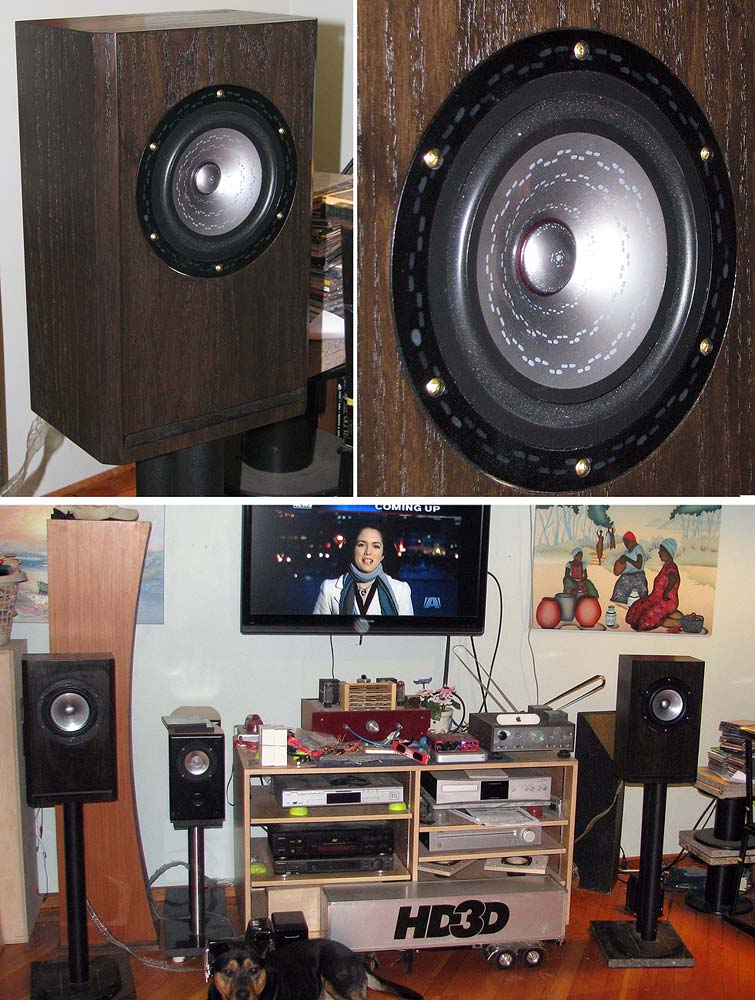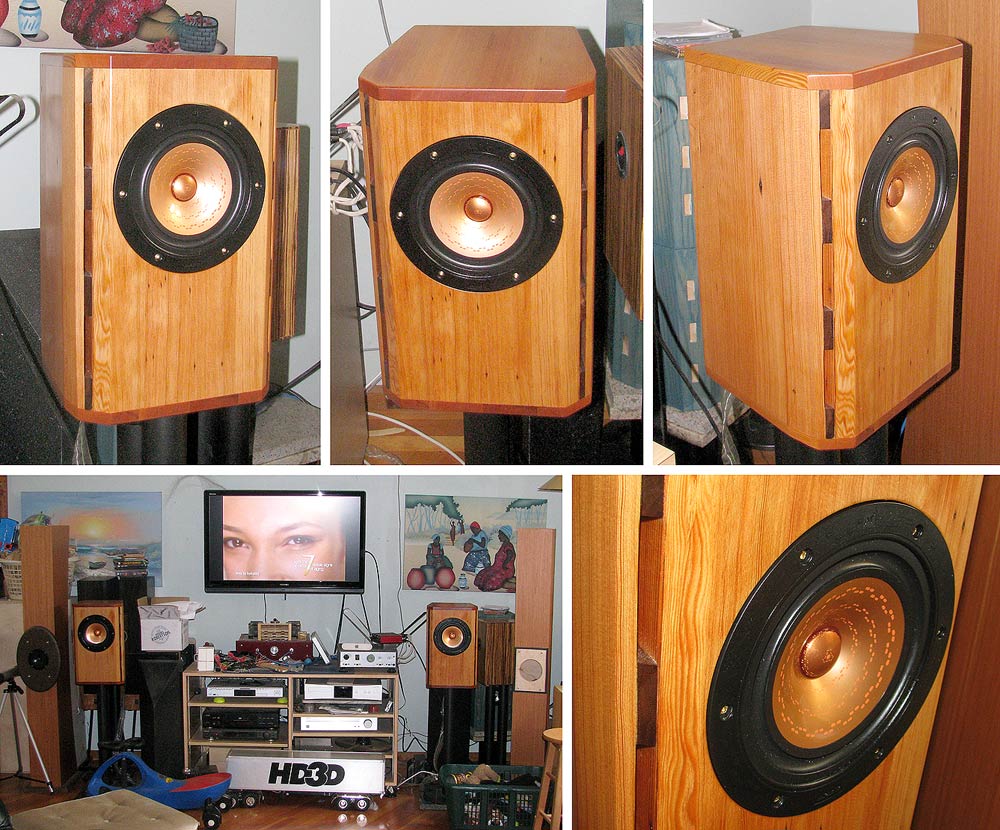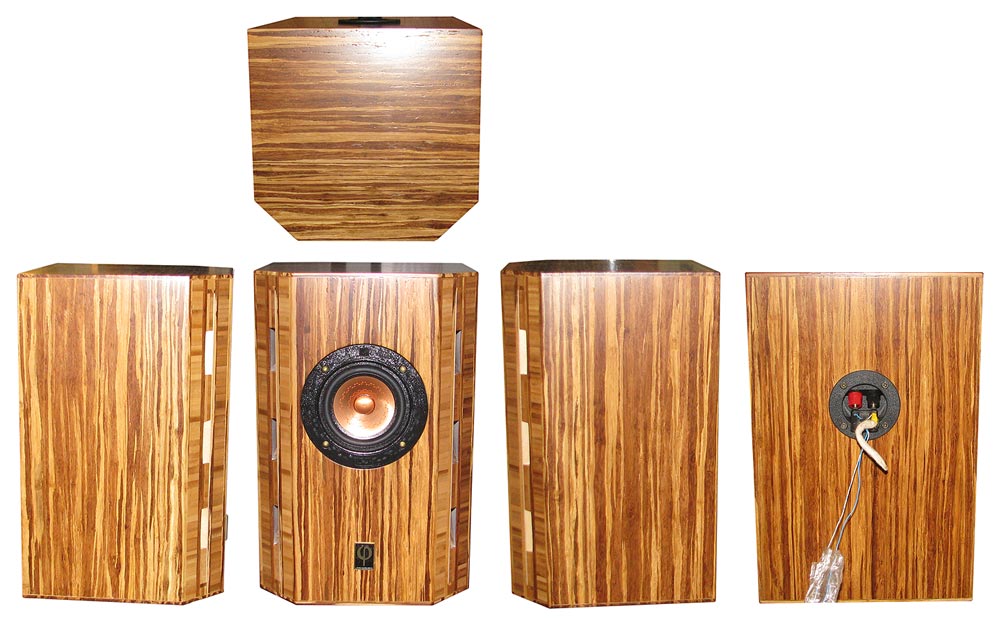looks like too many edges nearby please try to find a better setup!
With nearfield setup we stumble directly into the next problem : The other channel speaker/cabinet edge(vertical) creates a strong dominating reflection! (rounded cab edges even worse)
what a science thrilling time!
With nearfield setup we stumble directly into the next problem : The other channel speaker/cabinet edge(vertical) creates a strong dominating reflection! (rounded cab edges even worse)
what a science thrilling time!
These dumb things definitely sound better with the pvc round overs than without. Hearing a lot of new stuff in songs.
Ah ah, can't find the photo but it's very similar, by Patrick Bateman
https://www.diyaudio.com/community/...on-an-open-baffle-project.161768/post-2116628
https://www.diyaudio.com/community/...on-an-open-baffle-project.161768/post-2116628
Last edited by a moderator:
These dumb things definitely sound better with the pvc round overs than without. Hearing a lot of new stuff in songs.
Given the design of this loudspeakers i'm not surprised it makes some changes. Maybe you should try same thing on your three ways too? Could even be asymmetrical ( larger radius at side closest to drivers).
How did you assess the results? In stereo? Try it with only one loudspeaker and with mono source if possible, it's revealing too.
Hi, here is one way how to visualize the sounds from edge diffraction. http://legacy.spa.aalto.fi/demos/diffr-visual/And what in terms of the whole cabinet? The thread is about the cabinet, not the baffle only. You would object that the baffle is where 'the sound leaves the speaker' so the game is there, but it isn't. The cabinet reflects ( and diffracts and refracts) the sound that bounces from all over so it become a ghost source, or better, many sources. How would you compute that ?
Yeah the whole structure affects, it gets complicated quickly. Luckily level gets down rather quick, for example if a box was one foot deep sound to back edge and back towards listening position is two foot roundtrip, 2ms, floor reflection could arrive earlier I think. Effect towards listening axis seems to be much less in amplitude than what front edge does. Effects of back edge sound source seem to be mostly toward off-axis and sound going all around would add it's thing, peculiar looking "ridge" in a polar graph. There is an effect but the front edge seems to be more important as it makes frequency response vary inside listening window. Still, not sure how audible this is, I have not done listening comparison like that, perhaps I should.
I'm kinda upset by how good these things are sounding. had to play vulfpeck birds of a feather for my partner as were super familiar with it and haven't heard it this good before. I just might have to pursue this idea further, these are cheap *** drivers and they sound phenomenal.
You can just keep going using large cardboard
to make that baffle even bigger.
to make that baffle even bigger.
These dumb things definitely sound better with the pvc round overs than without. Hearing a lot..
Hi, what is your listening distance? can you perceive difference in sound everywhere in the room, further away? what if you replaced the roundovers with sharp edge, but maintaining the extra size with the baffle?I'm kinda upset by how good these things are sounding. had to play vulfpeck birds of a feather for my partner as were super familiar with it and haven't heard it this good before. I just might have to pursue this idea further, these are cheap *** drivers and they sound phenomenal.
Last edited:
The latteral rflexions of the cabinet matter, I surmise. However I still wonder about the last half part of the cabinet towards the back that see the front wall.And what in terms of the whole cabinet? The thread is about the cabinet, not the baffle only. You would object that the baffle is where 'the sound leaves the speaker' so the game is there, but it isn't. The cabinet reflects ( and diffracts and refracts) the sound that bounces from all over so it become a ghost source, or better, many sources. How would you compute that ?
Tear drop for this half part would be better than straigth sides and back pannel as wide as the front ?
Again Dickason shown Briggs measurements. For what is near 4 pi or below the 2pi to4 pi transition due to the fronr baffle width and shape, shape should be more for the eyes ...at least for the coherency of the look.
Btw what happened to the SF Stradivari wild baffle...rhe new model is way uggly vs rhe beautifull former.
The teardrop is something chosen to facilitate laminar flow, such as that over a vehicle. A sound wave travelling normal to the surface is a different thing.Tear drop for this half part would be better than straigth sides and back pannel as wide as the front ?
Sure, the cabinet is a diffusor and is not advancing like a vehicle towards a resistance. this is more the frequencies playbacked that shape the patern of air vibration... as the length of its energy structure we call the wave length. LIke beaming when you increase the frequency for illustration.
Cabinet shape could be seen as break'ups for straigth vibration propagation ? So that does not bounce on the surface but stop vibration propagation on the surface -barrier- and beyond the break up due to abrupt angle change - barrier too for all being beyond the angle if this last is higher in dimension than the wave length of the WL playback it "stops" -?
I.e. the recess if the tear drop going to the back is not seen by vibration cause the tear drop front acts as a barrier that stop air vibration transmission towards the half back then less bouncing at higher frequency towards the front wall and room angles? Someting exactly opposite of an open baffle?
Cabinet shape could be seen as break'ups for straigth vibration propagation ? So that does not bounce on the surface but stop vibration propagation on the surface -barrier- and beyond the break up due to abrupt angle change - barrier too for all being beyond the angle if this last is higher in dimension than the wave length of the WL playback it "stops" -?
I.e. the recess if the tear drop going to the back is not seen by vibration cause the tear drop front acts as a barrier that stop air vibration transmission towards the half back then less bouncing at higher frequency towards the front wall and room angles? Someting exactly opposite of an open baffle?
Last edited:
If you look at the old measurements Olson did on cones, you instantly know a teardrop shape isn’t that optimal. Of course aesthetics play a role too, but any ‘point or corner’ shape causes sharp diffraction and DI anomalies on a broad spectrum. The polar pattern isn’t per se bad, but it won’t be uniform in all directions. Should be basic knowledge to anyone designing enclosures.
Yes - I agree. The shape of the cabinet on the sides and back DOES have some effect on the diffraction signature, but complicated-to-build teardrop shape is not necessary. Other shapes can achieve the same effect with less complexity. The teardrop shape looks really cool, however.The teardrop is something chosen to facilitate laminar flow, such as that over a vehicle. A sound wave travelling normal to the surface is a different thing.
In my opinion, the most effective practical steps to reduce high frequency diffraction (above the baffle step) are these in order
1) recess the tweeter flange into the baffle
2) apply a modest radius or bevel to the baffle edges
3) recess midrange and/or woofers
4) apply a very large radius or bevel to the baffle edges to minimize the flat baffle surface around the drivers, particularly the tweeter.
5) profile the sides/back edges of the cabinet with radius or bevels
The first two steps provide the biggest benefit. Steps 3 - 5 will raise the performance in smaller steps.
I believe that high performance cabinet design should strive to mimic the radiation pattern of one of two ideal shapes: either an infinite baffle or a sphere. Flush mounting in a wall is very close to an infinite baffle. A small rectangular box with very large bevels or radius (if properly proportioned) can be pretty close to a sphere. A very wide panel with large radius edges can act as an infinite baffle above the some frequency, and this is an effective approach. There are a lot of effective approaches, including cylindrical shapes, truncated pyramids, etc...
j.
The shape of the cabinet on the sides and back DOES have some effect on the diffraction signature, but complicated-to-build teardrop shape is not necessary. Other shapes can achieve the same effect with less complexity.
The miniOnken come in 3 basic shapes.
The CGR (Classic Golden Ratio), is a rectangualr box. Easiest to build.
Rectangular is a rectangular box with relatively large bevels which include the 3 layers of material making up the vents. Harder to build.
Trapezoid takes the above box and angles the sides inwards towards teh back.
Direct comparison of the CGR to the trapezoid shows the more complex shape has the lowest diffraction signature which is most obviously auditable in how the box disappears.
CGR then the trapezoid (the actual ones we tested).


For completness a good illistration of the Rectangular miniOnken

Despite the truth in what Allen says, i believe the teardrop is a good target. B&W spent more $$$ extending Olson’s seminal research to end up with the Nautilus shape. A plan view of a trapezoid with a tear-droppish shape on top.

dave
Hi, what is your listening distance? can you perceive difference in sound everywhere in the room, further away? what if you replaced the roundovers with sharp edge, but maintaining the extra size with the baffle?
LP is about 4-4.5 feet.
Yeah I can perceive a difference everywhere in the room. The cabs have small roundovers so idk how to test hard edges.
If anyone wants to play around here's the speakers tweeter and woofer measured outside. It was windy as hell though and cicadas are loud.
Attachments
Baffle widens amount of the radius times two, doubles almost eye balling the picture. Doubling width would drop bafflestep down roughly a octave, directivity would increase on that octave, so I suspect its not only diffraction secondary sound source that changes the sound.
I assume the 1530 is creating the best imaging out of the three options. The mid/tweeter sees to each direction different baffle width which should result in a more homogeneous and lower edge diffraction. Off-centre placement is measurable better than centred but having a slim design helps especially in room integration. The already mentioned teardrop like enclosures are aesthetically pleasing and bring all the benefits of a slim enclosure with the minimum of edge diffraction issues. In the end the optics are the winning point - happy waifu happy laifu! Unmeasurable!!!Hi all,
To my knowledge, the narrower baffle will provide a better image of sound. However, there are some designs that are likely to be considered narrow baffles, despite the full-sized enclosures. For example, the old ADS speakers model LXX30 series; here I'll use the L1530 as an example.
As can be seen, the midrange and tweeter of the L1530s are mounted on a small baffle located at the edge of the cabinet.
I'd like to compare the cabinet shapes of the L1530 and L1590, as depicted in the attached.
1) IF EVERYTHING, including the drivers and crossovers, is the same, which model will give a better image of sound?
2) In my view, the L1590s perhaps give a better image, but how about if we change the L1530 to the flagship L2030? The L2030 has four midranges installed in a vertical array. Hence, could it compensate for the destroyed image and result in a better image than the L1590?
- Home
- Loudspeakers
- Multi-Way
- Which shape of cabinet gives a better image?